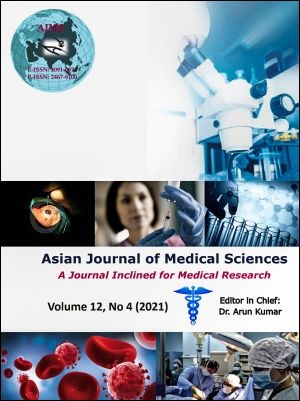Association of inflammatory biomarkers with radiological severity for COVID-19 patient risk stratification: An Indian perspective
Keywords:
Covid – 19, D-dimer, LDH, CRP, Ferritin, IL 6Abstract
Background: Covid – 19 caused by SARS-CoV2 was declared a global pandemic by World Health Organization. Due to rapid disease progression causing severe and fatal complications, Effective biomarkers like D – Dimer, serum ferritin, CRP, IL-6, LDH would be helpful in screening, categorization of patients, their clinical management, and prevention of serious complications, especially in areas where radiological facilities are
not available immediately.
Aims and Objectives: The study was aimed to investigate association between levels of inflammatory biomarkers with Covid – 19 disease severity and correlate it with HRCT chest finding to identify patients at risk of fatal complications.
Materials and Methods: It was a retrospective monocentric observational study undertaken at a tertiary-care, COVID-19 dedicated centre. 200 Patients>18 year of age who were admitted from August 1, 2020 up to October 31,2020 with laboratory confirmed diagnosis of Covid – 19 were included in the study. Data was collected on demography, disease severity, laboratory measurements, radiology imaging retrospectively from electronic and laboratory records of patients. The disease severity was classified into mild to severe based on CT Severity scoring. HRCT Chest and inflammatory biomarkers were sent in every patient at the time of admission and the outcome was recorded.
Results: There were 133 male patients, 67 female patients in our study. Average age of patients having severe lung involvement is 54.1 years, whereas Average age of patients having non-severe lung involvement is 52 years but showed No significant association with severity of lung involvement. Severity of lung involvement according to HRCT chest findings was greater in patients with raised values of both D – Dimer and ferritin (RR:3.67, P value:<0.0001), compared to combination of raised value of D – Dimer with LDH (RR: 2.56, P value: 0.0383) or D – Dimer with CRP(RR:2.22, P value:0.0157) or isolated D– Dimer (RR:2.87, P value: 0.0727). Individually raised levels of serum ferritin, LDH and CRP were also found to be significantly associated with radiological severity among covid-19 patients. Neither raised IL-6 levels (p=0.368, RR: 0.76) nor did combined raised value of D – Dimer with IL-6 showed significant association with HRCT severity in our study (RR: 1.69, P value: 0.1193). Pearson correlation coefficients were also calculated and serum LDH showed strongest correlation with increasing lung involvement in HRCT chest, followed by serum ferritin.
Conclusion: Based on the significant association, combination of D – Dimer with ferritin as well as isolated levels of inflammatory markers can help in assessing the severity of Covid – 19 disease based on its correlation with radiological severity, thereby it will help in immediate categorization of patients into different risk groups following diagnosis, to ensure optimal resource allocation.
Downloads
Downloads
Published
How to Cite
Issue
Section
License
Authors who publish with this journal agree to the following terms:
- The journal holds copyright and publishes the work under a Creative Commons CC-BY-NC license that permits use, distribution and reprduction in any medium, provided the original work is properly cited and is not used for commercial purposes. The journal should be recognised as the original publisher of this work.
- Authors are able to enter into separate, additional contractual arrangements for the non-exclusive distribution of the journal's published version of the work (e.g., post it to an institutional repository or publish it in a book), with an acknowledgement of its initial publication in this journal.
- Authors are permitted and encouraged to post their work online (e.g., in institutional repositories or on their website) prior to and during the submission process, as it can lead to productive exchanges, as well as earlier and greater citation of published work (See The Effect of Open Access).




